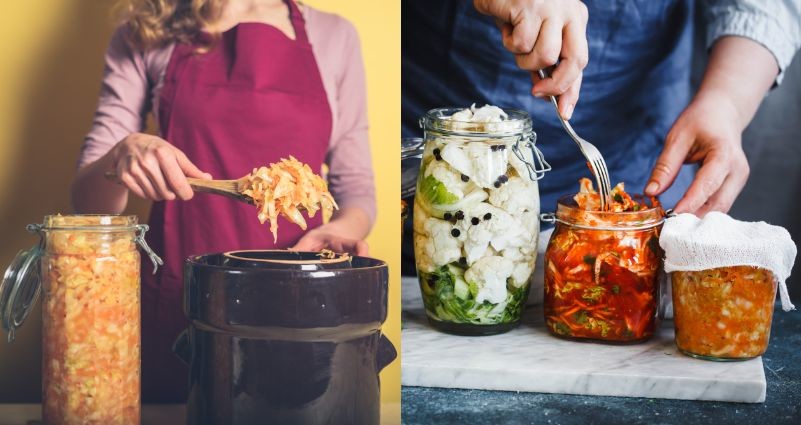
If you consider yourself a fan of pickles, you haven’t done your taste buds justice until you learn how to use a fermentation crock to make them at home.
This simple technology transforms the taste of preserved veggies to bring out their tangy, complex flavor that’s almost impossible to find in the grocery store.
Best of all, breaking down plant fibers through fermentation makes their nutritional content more accessible for you, ensuring that making your pickles in a fermentation crock is one of the best things you can do with that bushel of cucumbers.
But why do you need a fermentation crock, will one really make a difference for your health and what’s the best type to buy?
You can decide for yourself once you look at the details below.
About Fermentation Crocks
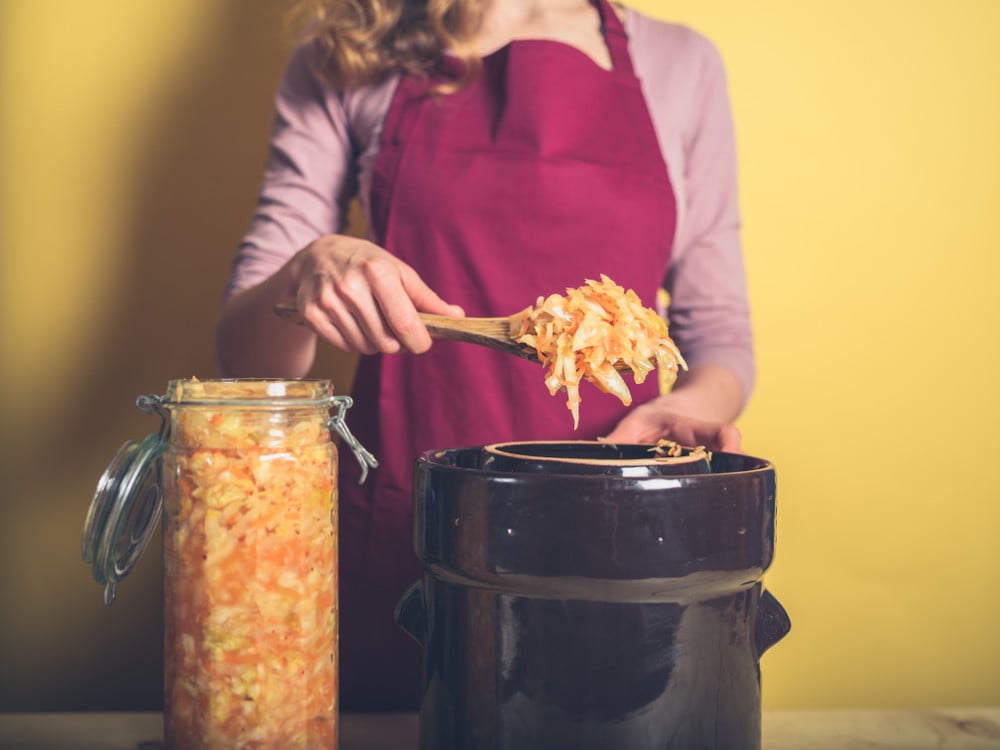
As the name implies, fermentation crocks are jars (usually ceramic) that are used to pickle produce by creating optimal conditions for anaerobic bacteria to thrive in. In this way, the crocks prevent food from spoiling so that it becomes preserved instead.
Most fermentation crocks are designed with a gutter in the rim that you keep filled with water during processing. This keeps air out of the container, which prevents yeast and surface molds from developing and contaminating the food inside.
Many crocks also come with ceramic weights that you place on top of the produce to ensure it stays submerged and fully ferments during the three-week processing time.
For a small amount of energy up front, you can feed your family on fresh ferments year-round and join a long history of humanity getting nourishment from preserved vegetables.
A History of Fermentation
Using a fermentation crock puts you in good company with a long history of people using microbes to preserve food. In fact, almost every human society relied on fermentation in some form or another before the ease of refrigeration.
Korea might be famous for kimchi, but the Eskimo survived the winters with ‘sour’ fish, and the Mongolians made fermented dairy products like ghee to keep milk from spoiling.
You’ll be even harder pressed to find a people group that didn’t occasionally indulge in fermented drinks like beer and wine.
The first fermentation “crocks” were barrel-sized vessels designed to ferment dozens of pounds of produce at once (and keep a family safe from scurvy throughout the winter).
You can still buy large-scale crocks today, but most fermentation is done on a more personalized scale.
In recent years, fermentation crocks have been rediscovered by homesteaders and gourmet chefs alike for preserving garden produce and enhancing the nutritional content of the food you eat.
Top 10 Benefits of Using a Fermentation Crock
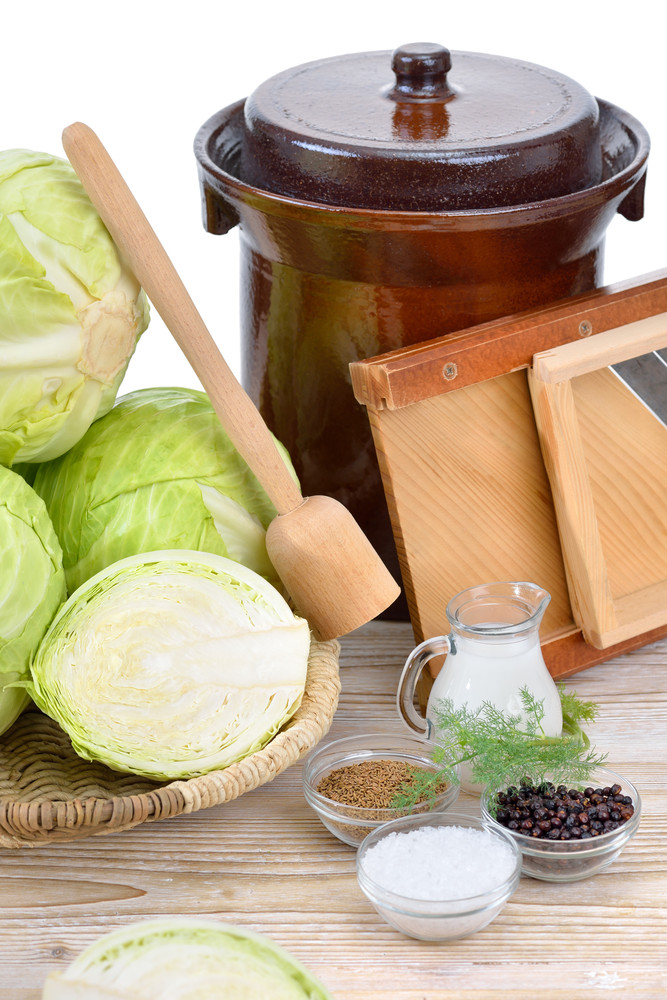
There are plenty of homesteading kitchen supplies to consider adding to your home, so why should a fermentation crock top your list?
In short, few other food preservation methods can provide you with as many profound advantages for your health.
1. Improves Bioavailability of Nutrients
One of the most profound benefits of fermentation is that it breaks down plant cells in ways that make it easier for your body to absorb their nutrients.
Research shows that fermented foods have more of the natural cancer-fighter vitamin K2, and the fermentation process breaks down natural toxins in fruits and vegetables so that they become harmless.
2. Better Gut Health
A healthy mix of gut bacteria is essential for digestion, and natural fermentation produces lactic acid, which aids their cultivation. This is because the fermentation process essentially pre-digests your food, ensuring that your gut has less work to do.
And, because low bacterial counts are connected with ailments like lactose intolerance, constipation, irritable bowel syndrome, gluten sensitivities and yeast infections, keeping your bacterial levels high can lead to a happier belly.
3. High Antioxidant Levels
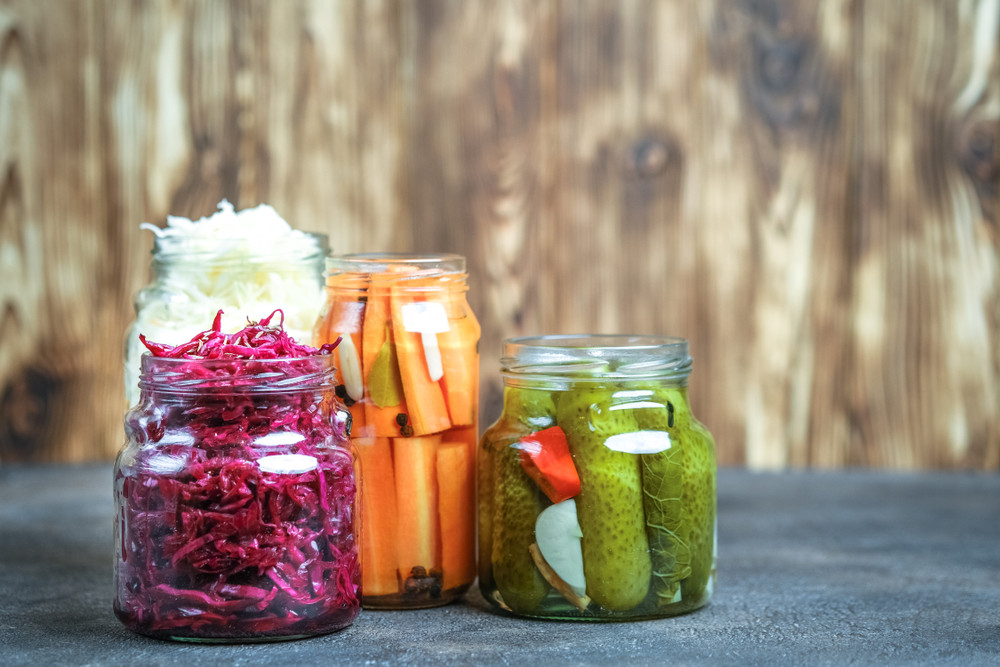
You might have heard that red cabbage is one of the healthiest, most antioxidant-rich foods on the planet, but few people are finding enough ways to incorporate it into their diet.
Making and eating sauerkraut (fermented cabbage) is a smart way to lower cholesterol levels and regulate your digestive functioning.
4. Elevated Vitamin Levels
The lactic acid produced during the fermentation process makes produce easier to digest. It also improves the accessibility of vitamins A and C.
Fermented dairy products also contain above average levels of B vitamins as well as folic acid, pyroxidine, biotin, and riboflavin.
5. Natural Cancer Prevention Properties
Fermented foods contain beneficial microorganisms that break down its nutrients and create natural binding agents called chelators. These bind to and remove toxins from the body, reducing your risk of free radical damage that leads to cancer.
There is also scientific evidence that vitamin K2 (a common nutrient in fermented food) has proven benefits for reducing your risk of prostate cancer.
6. Natural Depression Fighter
Filling up on fermented foods might help you keep depression symptoms at bay.
Early research shows that the fermentation process has a profound impact on the brain because it creates a natural antidepressant agent in sauerkraut and kimchi.
7. Consume Less Sodium and Sugar
While other food preservation methods (like canning) rely on copious amounts of sugar or salt to do the preservation work, fermentation makes use out of naturally present bacteria and yeasts instead.
8. Keeps Food Preserved
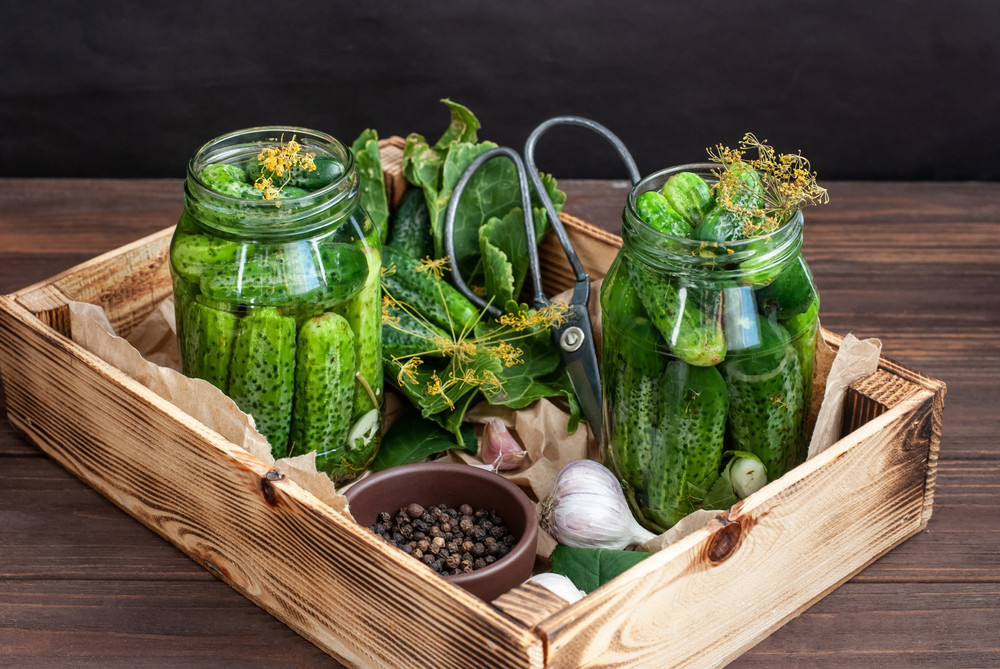
If you get overwhelmed by the cucumber production in your garden each year, fermentation is the perfect way to store your produce for future use.
The process essentially partially digests the food, which stops it from spoiling quickly and adds weeks (even months) to its shelf life.
9. Low-Cost Preservation
Homesteading hobbies can get expensive, but a fermentation crock should only be a one-time purchase. So long as you invest in quality, yours will last for decades of regular use, and the fermentation process requires little more than some salt and fresh produce to work its magic.
10. Increase Food Flavor
There’s a reason why aged wines and stinky cheeses are endlessly popular – fermentation brings out their flavor profile and produces a taste sensation like no other. You can get the same benefits with vegetables if you put them through the same microbial process in a fermentation crock.
The Difference Between Pickling & Fermenting
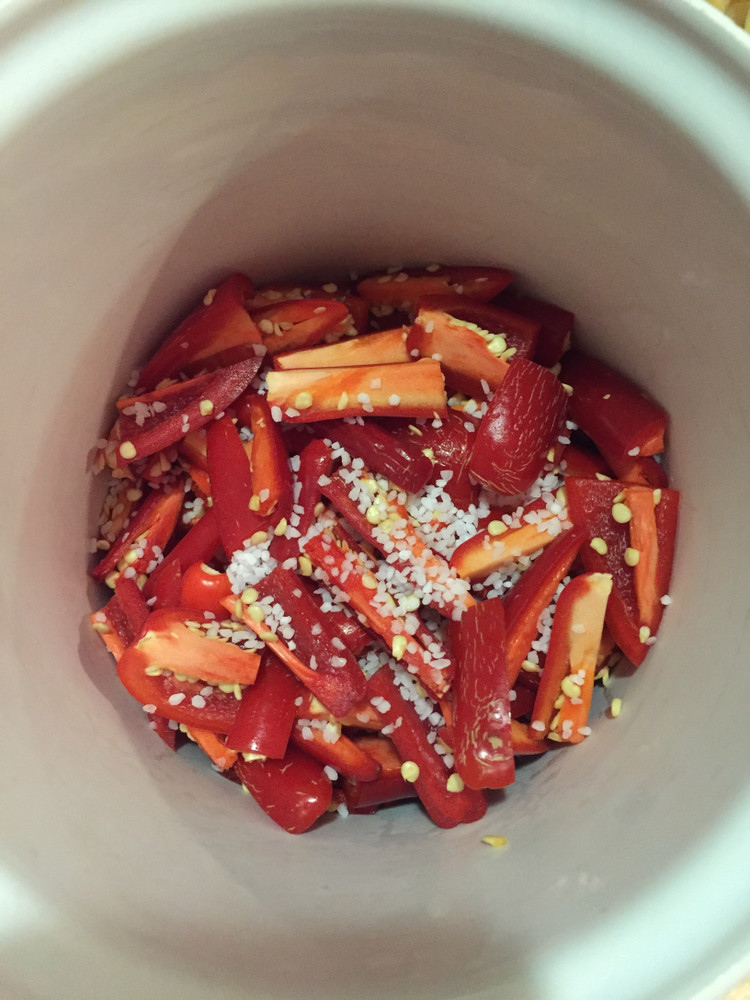
You’re forgiven for thinking that pickling and fermenting sound similar. The results might be easily confusable, but the two preservation strategies actually have distinct health benefits.
Pickling preserves food by halting the decomposition process with salt or vinegar, while fermentation relies on naturally-occurring enzymes, yeasts, and bacteria to convert the produce’s carbohydrates into carbon dioxide or alcohol. Salt is usually used to guide the process and enhance the flavor, but it’s not technically needed as a preservation agent.
What does this difference mean for your health? For one, the pickles and sauerkraut that you can get from the grocery store are both pickled and pasteurized, which means that the produce goes through a flash heat process that kills any potential pathogens, but compromises the nutritional benefits in the process.
In contrast, using a fermentation crock lets you take in the full nutritional content of your food without putting yourself at any health risks.
How Do Fermentation Crocks Work?
There’s no reason to be intimidated. Fermentation crocks are as low tech and easy to operate as they look, and you won’t need to rely on refrigeration or a power source for any part of the process.
Plan on it taking about three weeks from start to end before you have your ferments, but you won’t need to be involved past the first day.
Before you use a crock for the first time, make sure you thoroughly wash it with hot, soapy water to kill off any lingering bacteria inside. The ingredients you add after depends on the recipe you’re following, but the general idea is to fill the crock with cucumbers, cabbage, or other vegetables before covering everything in salt and a small amount of water.
It’s vital that the veggies always stay submerged to ferment correctly, so you can put the included ceramic weights on top to keep them down.
If you use a water-sealed crock, the next step is placing the lid on top and filling the lip with water. The gases produced during the fermentation process will cause this lip to “burp” as it releases them before instantly sealing itself again. This prevents oxygen and outside bacteria from contaminating the interior.
Fermentation is a highly personalized process, so there are few hard-and-fast rules for knowing when your food is done.
Take taste tests every few days to gauge the food’s flavor, and once it reaches a concentration you like, stop the fermentation process by storing everything in the fridge, either in or out of the crock.
Or, if you prefer, can the contents with a water bath canner to preserve it longer.
How to Choose the Best Fermentation Crocks
Determining which fermentation crock makes sense for you isn’t always an easy decision. That’s because there are several distinct types to choose from, each with unique characteristics to consider.
Below are three of the most popular kinds of fermentation tools available.
Open crocks
As the traditional approach for fermentation, open crocks are a common sight in antique shops, and the odds are good they were a well-used tool in your grandma’s house. These crocks couldn’t be simpler to use, as the open top and straight walls make them easy to clean, and you can easily stuff whole vegetables inside for fermentation before packing them down with weights.
However, because only a cloth is used over the top, you have a higher risk of contamination from insects or outside bacteria, and the produce occasionally develops an unappetizing (but harmless) surface mold.
Best Pick: 5 Gallon Stoneware Pickling Crock
Water-sealed crocks
Considered to be the gold standard for fermentation lovers today, water-sealed crocks are similar to open ones, with the significant difference that it has a lip for collecting water and a lid is placed on top to prevent outside air from entering.
This dramatically reduces any chances of mold forming, and it keeps all funky fermentation odors entirely within the crock.
Water-sealed crocks require slightly more maintenance (you need to refill the water in the moat on occasion), and the shape of the top often makes it more challenging to clean afterward.
Best Pick: Kerazo 5L German Made Fermenting Crock Pot
Food-Grade Plastic Bucket
Not all fermentation crocks are ceramic. Food grade plastic buckets also provide an option for home fermentation.
While these tend to be appealing because they are lighter and easier to move, many experts don’t recommend them because of their potential to produce mold. Also, the lactic acid produced during fermentation can react with the plastic and potentially leach toxins into your food. (Even BPA-free plastic isn’t a 100% safe bet).
Which Size Fermentation Crock is Best?
Once you determine the kind of crock you want, settling on size is the next step. Crocks can vary in capacity from just two liters to over 25 liters, and certain proportions are better suited for different tasks.
For instance, you can get by with a simple two-liter system if you only want a personal supply of sauerkraut, but larger crocks are better for fermenting large chunks of produce, like whole corn on the cob.
Some questions to ask before determining your crock size include the following:
- What do you plan to ferment? Bulky foods like pickles and whole onions need more space.
- Will you be able to pick it up and move it around? Ceramic jars are surprisingly heavy once they get full.
- Will you be able to fit it in the sink for washing? Large crocks are convenient for fermenting, but they can be cumbersome to clean later.
Note: Keep in mind that crock sizes are based on the inside capacity, not the overall volume. Also, food shrinks as it ferments, meaning that you might get three liters of sauerkraut from a ten-liter jar.
A smart size for households interested in delving into fermentation is five liters. You can pack it with up to ten pounds of cabbage and expect between five and six quarts by the end.
7 Best Recipes for Using a Fermentation Crock
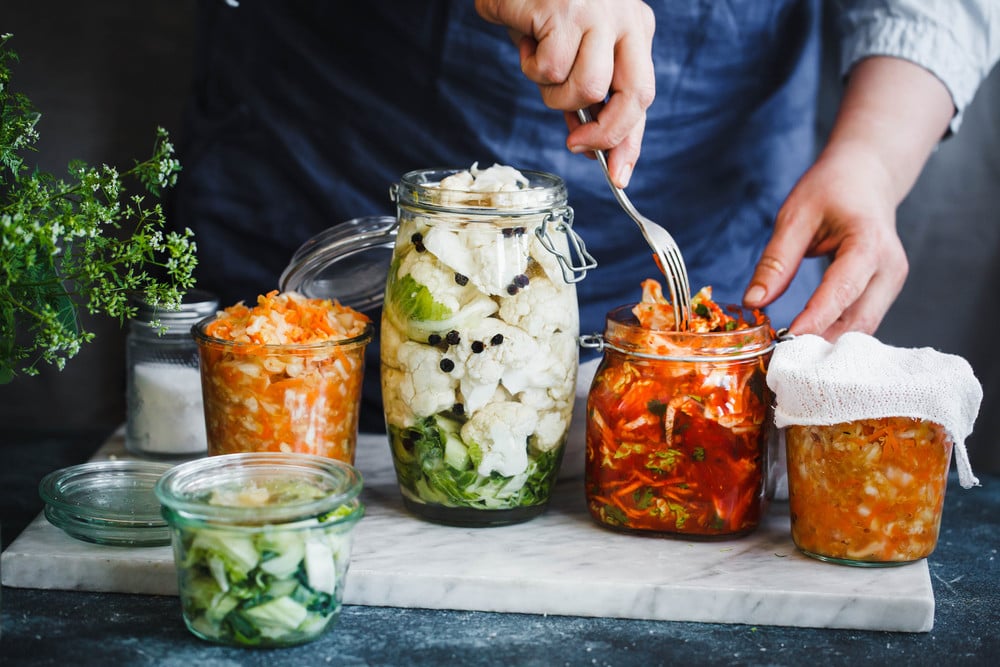
Not sure how best to put your fermentation crock to use? These recipes are a stellar starting point.
- Sour pickles from WildFermentation.com
- Fermented Dill Pickles from ProdigalPieces.co
- Five-step sauerkraut from TheRadiantLifeBlog.com
- Sweet Garlic Sauerkraut
- Ruby Red Caraway Sauerkraut from GardenersSupplyCompany.com
- Kimchi Fermentation Crock Video Recipe from Brookstone Inc
- Pickled Fermentation Crock Corn on the Cob from FieldandStream.com
Remember: Home fermentation is more of a science than an exact art. The process is influenced by the yeasts and microbes in your home, so no two batches ever taste quite the same. Stay open to experimentation and keep in mind that the learning process is part of the journey towards proficiency.
After a few rounds of use, you’ll develop a sense for how you like your flavors to build, and your fermentation crock will become an invaluable household tool for years to come.
